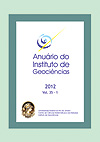Geodiversity: some considerations about quantification and evaluation of spatial distribution
DOI:
https://doi.org/10.11137/2012_1_90_100Abstract
The geodiversity term has been used to attend the needs of geosciences researchers to refer the complex's physical landscape, covering the abiotic elements such as rocks, landforms, soils and rivers, for example, configured as an analogue to the biodiversity term. The various components of geodiversity and biodiversity, combined, make up different physical environments, which allow a quantitative analysis of space, wealth and abundance. This paper aims to identify the main aspects of convergence between the geodiversity and biodiversity, paying attention to the relationships sample in each case, spatial distribution, richness of diversity and the relationship between rate of geodiversity and geological heritage. By establishing general guidelines on the quantitative interpretation of geodiversity and biodiversity, it is clear that both use a pre-defined spatial area. Biodiversity is generally based on sampling units of several sizes due to the impossibility of direct quantification of diversity in all area. In the case of geodiversity is necessary to establish a maximum and minimum scale of assessment, and based on this scale of reference, establish a spatial distribution of elements through the mapping (geological, geomorphological and pedological) and instrumental tool. The quantitative assessment of geodiversity, whose methods are still being evaluated, can supports a better understanding of the physical environment and can also provides results for the identification and assessment of geological, geomorphological and paleontological heritage. However, it is necessary to know that the diversity of life or abiotic elements of an environment represents a very complex context and therefore must be understood beyond a mere numerical index that spatializes the diversity of the constituent parts of the whole.Downloads
Download data is not yet available.
Downloads
Published
2012-06-01
How to Cite
Manosso, F. C. and Ondicol, R. P. (2012) “Geodiversity: some considerations about quantification and evaluation of spatial distribution”, Anuário do Instituto de Geociências. Rio de Janeiro, BR, 35(1), pp. 90–100. doi: 10.11137/2012_1_90_100.
Issue
Section
não definida
License
This journal is licensed under a Creative Commons — Attribution 4.0 International — CC BY 4.0, which permits use, distribution and reproduction in any medium, provided the original work is properly cited.















